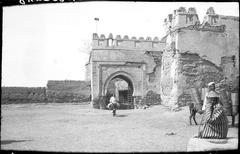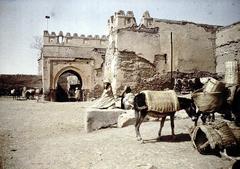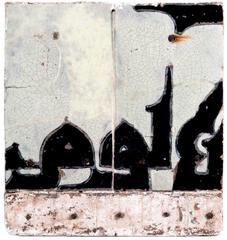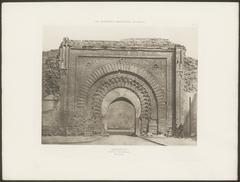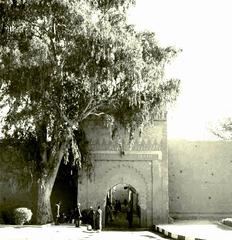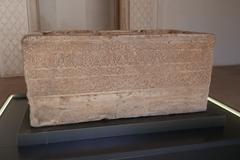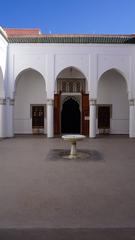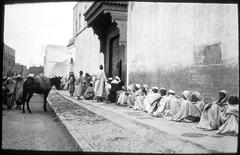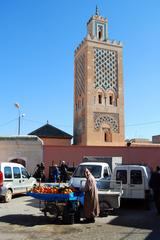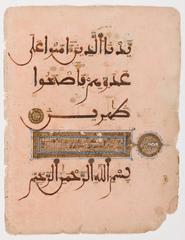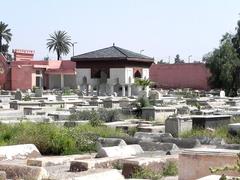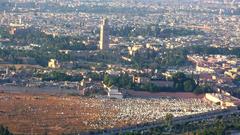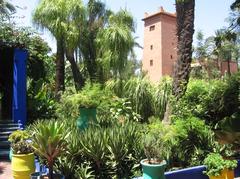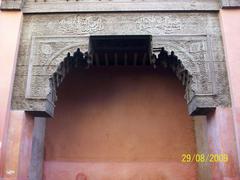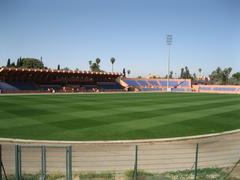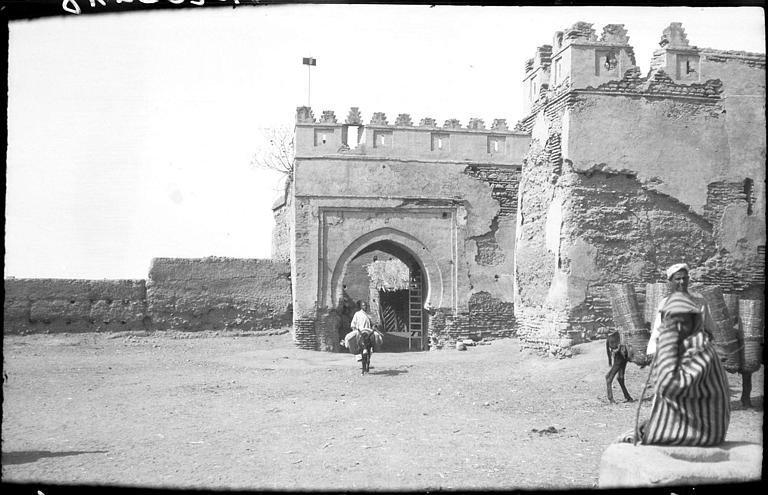
Bab Aghmat Visiting Hours, Tickets, and Historical Sites in Marrakesh
Date: 15/06/2025
Introduction to Bab Aghmat and Its Significance
Bab Aghmat is one of Marrakesh’s most historically significant and architecturally distinguished city gates. Erected during the Almoravid dynasty around 1126–1127 CE under the reign of Ali ibn Yusuf, this southeastern entrance to the medina connected Marrakesh with the ancient Berber city of Aghmat and crucial trans-Saharan trade routes. Featuring a bent entrance and robust masonry adorned with geometric motifs, Bab Aghmat reflects the sophisticated military and artistic ingenuity of its era. Its enduring presence is a testament to the city’s layered identity, shaped by Arab, Berber, and Andalusian influences (The New Arab; Archnet; Wikipedia).
Today, Bab Aghmat stands integrated into the bustling rhythm of the medina. As an open and accessible monument, it offers a gateway not only into Marrakesh’s past but also to nearby sites such as the Mellah (Jewish quarter), Saadian Tombs, Bahia Palace, and vibrant traditional souks (Nomads Travel Guide; Trek Zone; Visit Marrakech). This guide provides a detailed look at Bab Aghmat’s origins, architectural features, practical visitor information, and its importance in Marrakesh’s cultural and urban landscape.
Table of Contents
- Introduction to Bab Aghmat and Its Significance
- Origins and Historical Context
- Architectural Features and Artistic Elements
- Role in Marrakesh’s Urban and Social Fabric
- Historical Events and Transformations
- Relationship to Other Historic Sites
- Practical Visitor Information
- Nearby Attractions and Suggested Itineraries
- Safety, Etiquette, and Responsible Tourism
- FAQs
- Visuals
- Conclusion and Recommendations
- References
Origins and Historical Context
Bab Aghmat was constructed as part of the original Almoravid fortifications in 1126–1127 CE, shortly after Marrakesh’s foundation in 1070 CE. Its name honors the ancient town of Aghmat, a former regional capital and major crossroads on pre-Marrakesh trans-Saharan trade routes (Wikipedia; The New Arab). The gate controlled movement into the city, serving defensive, economic, and administrative functions.
Strategically located for travelers and caravans arriving from the southeast, Bab Aghmat played a vital role in the city’s security and prosperity. Its proximity to the road leading toward Aghmat and the Atlas Mountains underscored Marrakesh’s connections to both its Berber roots and broader trade networks (Alksar; Morocco Travel Blog).
Architectural Features and Artistic Elements
Historical Construction
Bab Aghmat exemplifies the military architecture of the Almoravid period, featuring thick, crenellated walls and a signature bent entrance. This design forced entrants to slow down and turn sharply, enhancing defensive capabilities (Archnet). The gate’s structure originally included high towers, arrow slits, and robust wooden doors reinforced with metal, all built using rammed earth (pisé) and brick.
Decorative Details
While primarily a defensive structure, Bab Aghmat displays subtle artistic embellishments. Its slightly pointed horseshoe arch, decorative brickwork, and geometric patterns reflect Almoravid and early Almohad design preferences. The gate’s restrained ornamentation includes interlacing patterns and blind arches, with remnants of stucco work occasionally visible (Archnet).
Integration with City Walls
Bab Aghmat forms part of Marrakesh’s extensive city wall system, which originally stretched for about 19 kilometers. The gate’s alignment with others such as Bab Aylan and Bab el-Khemis demonstrates a carefully planned defensive network (Nomads Travel Guide).
Restoration and Preservation
Over centuries, Bab Aghmat has undergone repairs and restoration, especially after conflicts and natural disasters, including the 2023 earthquake. Conservation aims to stabilize the structure, maintain original materials, and ensure safety for visitors (Archnet).
Role in Marrakesh’s Urban and Social Fabric
Bab Aghmat has historically served as a focal point for movement, commerce, and cultural exchange. It was the gateway for caravans bringing goods from the southeast, and a checkpoint for traders and pilgrims. The area around the gate became a melting pot of communities, including Arabs, Berbers, and Jews, fostering a cosmopolitan atmosphere that persists today (The New Arab).
The gate marks the transition between the organized, walled medina and the surrounding countryside. Its regulatory role in overseeing trade and taxation contributed to Marrakesh’s economic and political vitality (Nomads Travel Guide).
Historical Events and Transformations
Bab Aghmat has witnessed significant historical events, such as the Almohad conquest in 1147, when it served as a strategic entry point for invading forces (Alksar). Over time, the gate became the site of ceremonial processions, religious gatherings, and community events. Urban expansion and modernization in the 20th century transformed its surroundings into a vibrant intersection, reflecting Marrakesh’s dynamic growth (Trek Zone).
Relationship to Other Historic Sites
Located within walking distance of other landmarks, Bab Aghmat is closely linked to the Mellah (Jewish Quarter), the Saadian Tombs, Bahia Palace, and Ben Youssef Madrasa. The nearby Slat al-Azama Synagogue and various cemeteries further highlight the area’s multicultural heritage (Trek Zone). This proximity makes Bab Aghmat an excellent starting point for exploring Marrakesh’s historical and cultural riches.
Practical Visitor Information
- Visiting Hours: Bab Aghmat is a public monument, accessible 24/7. For safety and the best experience, visit during daylight hours (typically 8:00 AM – 6:00 PM).
- Tickets: Visiting Bab Aghmat is free. Entry fees apply to some nearby attractions, such as the Saadian Tombs (~70 MAD as of 2025) (HikersBay).
- Accessibility: The gate is at street level, but medina alleys are narrow and uneven. Wheelchair and stroller access may be limited.
- Transport: Arrive by taxi, public bus, caleche, or on foot. Taxis are most convenient from the airport or train station; agree on fares in advance.
- Guided Tours: Numerous guided walking tours include Bab Aghmat. Booking ahead is recommended, especially in peak seasons.
- Photography: The gate is photogenic, especially in early morning or late afternoon. Always ask permission before photographing locals.
- Facilities: Basic amenities (cafés, shops, restrooms) are nearby, with more options in the Mellah and Place des Ferblantiers.
Nearby Attractions and Suggested Itineraries
- Saadian Tombs: 16th-century necropolis famed for intricate decoration (open daily, entrance fee required).
- Mellah (Jewish Quarter): Historic synagogues, cemetery, and bustling spice markets.
- Bahia Palace: Architectural masterpiece, about a 15-minute walk away.
- Place des Ferblantiers: Lively square known for metalworkers and crafts.
Suggested itinerary: Begin at Bab Aghmat, stroll through the Mellah, visit the Saadian Tombs, and enjoy lunch at a nearby café. Evenings are perfect for shopping or relaxing on a rooftop terrace.
Safety, Etiquette, and Responsible Tourism
- Safety: Marrakesh is generally safe, including Bab Aghmat’s area. Remain vigilant against petty theft, especially in busy markets (Local Adventurer).
- Health: Carry bottled water, use sun protection, and consider recommended vaccinations. Private clinics are preferred for medical needs (HikersBay).
- Dress Code: Modest, lightweight clothing covering shoulders/knees is best. Women may carry a scarf for extra coverage (Rough Guides).
- Customs: Respect prayer times, avoid public displays of affection, and support local artisans. Bargaining is customary but should be polite.
FAQs
Q: Is there an entry fee for Bab Aghmat?
A: No, visiting Bab Aghmat is free.
Q: What are the visiting hours?
A: The gate is accessible at any time, but daylight hours (8:00 AM – 6:00 PM) are recommended.
Q: Are guided tours available?
A: Yes, many tours include Bab Aghmat. Booking in advance is advised.
Q: Is Bab Aghmat accessible for those with mobility issues?
A: The gate is street-level, but nearby medina streets can be challenging.
Q: Can I visit other historical sites nearby?
A: Yes, the Saadian Tombs, Mellah, and Bahia Palace are all within walking distance.
Q: When is the best time to visit?
A: Early mornings and late afternoons offer the most pleasant conditions, especially in summer.
Visuals
For more visuals, consult tourism websites or official Marrakech resources.
Conclusion and Recommendations
Bab Aghmat stands as a remarkable synthesis of Marrakesh’s architectural heritage and multicultural identity. As one of the city’s original Almoravid gates, it offers an immersive experience for history enthusiasts, architecture lovers, and cultural explorers alike. Its strategic location near the Mellah, Saadian Tombs, and Bahia Palace makes it an excellent starting point for delving into Marrakesh’s historical treasures.
Visitors are encouraged to plan their trip during daylight hours, wear comfortable shoes, and respect local customs for an enriching experience. Guided tours and digital resources like the Audiala app can deepen your understanding and make navigation easier. Whether you’re seeking to explore ancient history, vibrant markets, or architectural marvels, Bab Aghmat is an essential highlight of any Marrakesh itinerary.
For further information, updates, and exclusive offers, download the Audiala app and follow us on social media. Explore related guides to optimize your visit to Marrakesh’s historical sites.
